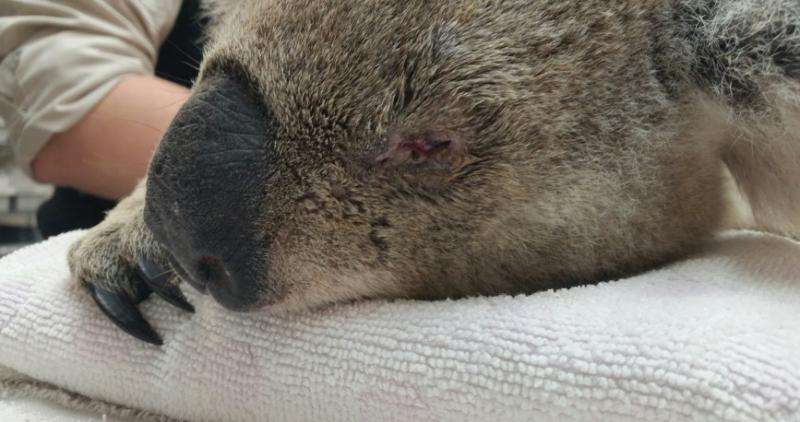A koala with chlamydial eye disease is examined by vets. Credit: Willa Huston
Scientists have made a breakthrough in their urgent quest for a new drug to treat koalas at risk of infertility, blindness, pneumonia and even death caused by chlamydia.
The painful and intractable disease is having a devastating impact on populations of Australia's beloved marsupial.
Specialist koala vets are using two antibiotics – Baytril and Chloramphenicol 150. However, there is less than two years' supply of Chloramphenicol 150 remaining and the drug is no longer on the market.
Neither of the current treatments works in all cases of chlamydial disease and a new treatment is urgently needed.
Microbiologist Dr Willa Huston, of the University of Technology Sydney, with collaborators at Australia Zoo Wildlife Hospital and elsewhere, has identified a chemical that paves the way for a new antibiotic to save koalas' lives.
In extensive laboratory tests on tissue samples from chlamydia-infected koalas, the researchers found the compound to be highly successful at killing the bacteria and low in toxicity against koala cells.
"It's really urgent now that we put a concerted effort into developing this treatment further," says Dr Huston. "Manufacture [of the old one] has stopped, supply has stopped, and it can take years to develop a new drug.
"We are in a desperate search to find new, effective treatments and test other drugs that might help koalas recover from this horrible disease."
Koalas are listed as a vulnerable species in NSW and Queensland. Fewer than 100,000 remain in the wild in Australia and are at risk from habitat loss, motor vehicle trauma, domestic dog attacks and, increasingly, disease.
Dr Huston says as many as one in five koalas in the wild in south-east Queensland and northern NSW have severe chlamydiosis; some studies have found as many as nine in 10 koalas with chlamydial infections. Wildlife veterinarians are also reporting that the disease is spreading south – infections have been reported in Victoria, where koala populations are larger, and South Australia, where koalas are listed as "rare".
Male and female koalas are affected by two species of Chlamydia – C. pecorum and C. pneumoniae. The first causes eye disease, including inflammation and discharge, or urogenital disease, including cystitis, urinary incontinence (known as "wet bottom") and fibrosis, which can cause infertility. The second strain causes severe respiratory illness.
Any new drug must be able to treat chlamydiosis while minimising side effects. As a specialised eucalyptus herbivore, the koala's metabolism is uniquely placed to deal with toxic plant compounds. However, koalas respond poorly to antibiotic treatments commonly used in humans, suffering side effects such as emaciation, and typically fail to recover completely from disease.
Dr Huston and her team are fine-tuning the chemical make-up of their discovery before they begin testing on sick koalas.
"Time is running out. We all treasure our koalas and we need to do everything we can to cure this disease."
The paper is published in the Nature journal Scientific Reports.
More information: Amba Lawrence et al. Chlamydia Serine Protease Inhibitor, targeting HtrA, as a New Treatment for Koala Chlamydia infection, Scientific Reports (2016). DOI: 10.1038/srep31466
Journal information: Scientific Reports
Provided by University of Technology, Sydney




















